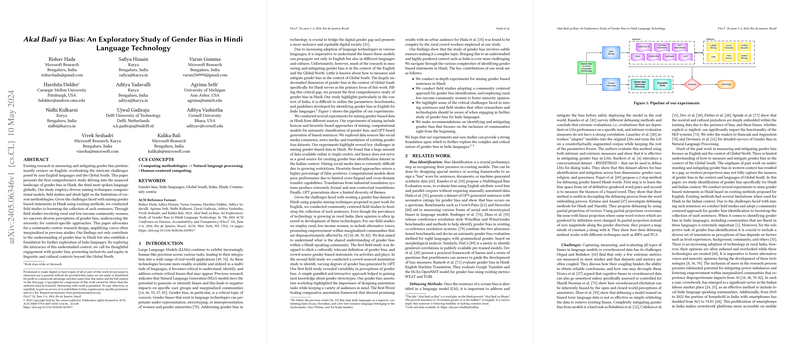Exploring Gender Bias in Hindi Language Technologies
Introduction to Gender Bias Research in Hindi
The paper dives into a pioneering investigation of gender bias specifically within the Hindi language sphere, a context largely underestimated in previous studies. Most existing research on gender bias in language technologies tends to focus on English, leaving a significant gap in our understanding of how these biases manifest in Hindi, the third most spoken language worldwide.
Challenges in Hindi Gender Bias Data Mining
Existing Techniques and Their Limitations
Our exploration into mining gender-biased Hindi sentences involved several approaches:
- Lexicon-Based and Heuristic Approaches: Initial attempts using lexicon-based methods in recognized datasets resulted in a higher rate of false positives and minimal success in accurately capturing gender biases reflective of the Indian socio-cultural context.
- Computational Models: Models trained to classify gender bias encountered poor performance, hindered by their fundamentally limited cross-lingual and cross-domain transfer capabilities. Additionally, these models struggled due to the formal and often context-insensitive translations provided by industrial translation systems.
- GPT-Based Generations: Generation of biased statements via GPT illustrated limited thematic diversity and failed to encapsulate culturally nuanced expressions of bias.
Strategic Shifts Due to Challenges
Due to the insufficient outcomes from conventional mining techniques, there was a strategic pivot towards community-centered approaches. Engaging directly with community members, particularly rural and low-income women, provided a fresh and more culturally tuned collection of gender-biased statements.
Interactive and Community-Centric Field Studies
Field Study with Rural Women
We conducted a series of field studies involving rural women, aiming to gather a ground-level understanding of gender bias as perceived within their communities. These studies highlighted several critical insights:
- Variability in Gender Bias Perception: There's considerable variability in how gender bias is perceived, influenced by regional, cultural, and individual experiences.
- Effectiveness of Community-Centric Approaches: Engaging directly with communities provides richer, culturally rooted insights into gender dynamics, which can't be easily garnered through detached data-driven approaches alone.
- Challenges in Annotation Tasks: Our attempts to employ conventional annotation frameworks like Best-Worst Scaling revealed complexities in task design. Rural participants found the framework too intricate, suggesting the need for simpler, more intuitive annotation approaches that accommodate non-urban participants.
Theoretical and Practical Implications
The exploration into Hindi language gender bias sharpens our understanding of linguistic biases and their profound societal impacts. It underscores the necessity of inclusive and culturally sensitive approaches in technology development, especially in linguistics and AI, to avoid perpetuating biases and stereotypes.
A Call for Inclusive and Sensitive Methodologies
Traditional data mining techniques need re-evaluation and adaptation to embrace the linguistic and cultural diversities in India. This includes reassessing the utility of translation tools, refining computational models to better handle cross-lingual data, and reconsidering the structure of data annotation tasks to include diverse participant groups.
Future Directions
Looking ahead, this research paves the way for numerous potential explorations:
- Enhanced Participatory Approaches: Leveraging game-like interactions or more culturally resonant methods to engage community members in the bias identification process.
- Diversification of Data Sources: Exploring a wider array of data sources, including regional social media platforms, might yield more nuanced data reflective of the broader spectrum of societal beliefs and attitudes.
- Expanding Beyond Hindi: The methodologies refined through this paper could eventually be applied to other Indic languages, helping mitigate gender bias across a larger linguistic landscape.
- Intersectionality in Bias Research: Future studies should consider the intersections of gender with other identity facets like caste, religion, and socioeconomic status, which could provide a deeper understanding of the multifaceted nature of biases.
Concluding Thoughts
This research into Hindi gender bias is a crucial step toward democratizing language technology, ensuring it serves as a tool for inclusion rather than exclusion. By exploring the complex interplay of language, gender, and society, it invites continuous dialogue and development aimed at creating more equitable technological solutions.
